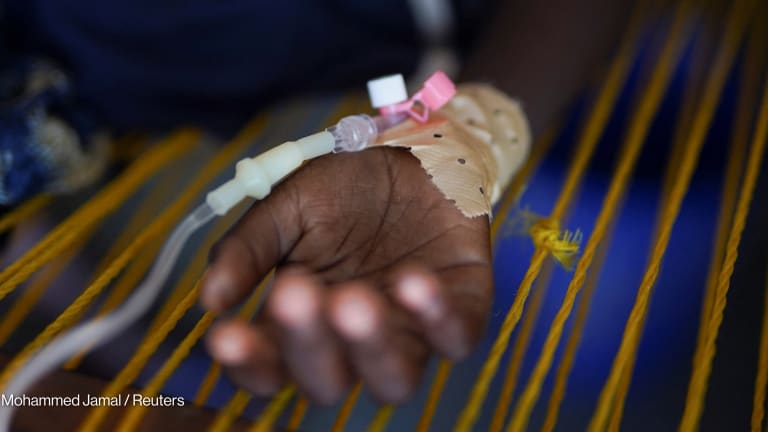
UNITED NATIONS — The United Nations Children’s Fund is starting 2018 with its largest appeal yet for humanitarian aid, reflecting the strain multiple protracted crises are placing on relief and development work across the world.
Some 84 percent of the $3.64 billion UNICEF is seeking would go toward conflict-driven crises, including Yemen, Syria, the Syrian refugee crisis, the Democratic Republic of the Congo, and South Sudan, Grant Leaity, the deputy director for UNICEF’s Office of Emergency Programmes, told Devex.
This would benefit 82 million people, including 48 million children, in 51 countries.
See more related topics:
► 3 million Yemeni children born in war face uncertain future, UNICEF says
► UNICEF's new executive director proposes a shift in priorities
► As US interest wanes, UNICEF pivots strategy
► Opinion: Yes, we can reach every child with accessible, quality care
“The first major trend to explain what is driving this is this ever-growing number of these protracted crises. When they [conflicts] are protracted, you have a series of different things playing into increasing humanitarian consequences,” Leaity said. “You have the conflict itself and other phenomenon playing. You can then have disease outbreaks and then natural disasters.”
The rising funding needs come amid the realization that not all these crises — and other, nonemergency areas of UNICEF’s work — will receive adequate support.
Last year, UNICEF mobilized about 65 percent of the $3.3 billion — totaling $2.48 billion — it requested for humanitarian assistance. In 2016, it sought $2.8 billion, and a greater sum of $3.1 billion in 2015.
Looking at overall trends, instead of “one specific data point” from a particular year is important, according to Leaity. Individual disasters, such as the 2010 Haiti earthquake, for example, could cause funding needs to spike year to year.
“If you look at the overall trend it [funding requests] is absolutely increasing year by year,” Leaity said. “The needs manifest themselves. At the moment, we are specifically concerned about water.”
Last year, there were a number of breakdowns of water and sanitation systems in countries in conflict, fueling the unprecedented number of cholera outbreaks in DRC, Iraq, northeast Nigeria, Somalia, South Sudan, and Yemen. There was a record-breaking million-plus suspected cholera cases in Yemen alone in 2017, with more than 2,200 deaths. The World Health Organization has said they expect another surge of the water-borne disease this spring once the rainy season arrives.
Last year DRC experienced its worst cholera outbreak in the last 25 years, resulting in at least 53,000 cases and 1,000 deaths as of January, as Devex has reported.
This year, UNICEF is seeking $337 million for Yemen, over $100 million more than it requested last year. DRC requires about $268 million, while Syrian refugees require the largest single amount, totaling $951.8 million.
Yemen, DRC, and Sudan faced the biggest funding gaps in 2017, ranging from 44 to 67 percent of funding shortages.
Governments choosing to earmark certain funds, directing where and how their money can be spent, is also having an impact on UNICEF’s increasing needs.
“It is somewhat [affecting these trends]. There’s no doubt,” Leaity said.
Work in education, water, sanitation, and hygiene account for about half of the 2018 humanitarian aid funds. Nutrition and health make up the next largest percentage of the requested budget, and child protection is another area of concern.
“We are seeing there is less and less respect of safe havens for children, places where they should be safe, like in hospitals, in schools. These places are under attack. We are seeing hospitals getting bombed, groups entering and using schools as military barracks, and schools getting literally shelled,” Leaity said.
Ongoing attacks in eastern Ghouta, Syria, last week included bombings of 14 hospitals, three health centers and two ambulances, according to U.N. estimates.
Humanitarian sector in DRC not able to access many of the affected populations
As the crisis in the Democratic Republic of the Congo continues to escalate, many affected populations are without, or with limited, assistance.
UNICEF’s humanitarian action plan, though, is likely an underestimate, not reflective of the needs of people in remote, or blocked conflict areas.
UNICEF’s access in DRC was “variable” throughout last year, according to Leaity.
“What you sometimes find is when you get the access, the humanitarian needs go up,” he said. “There are a very significant number of people in Ituri province we do not have access to right now as we speak. If we go into other areas, there is also a concern of them becoming extremely difficult to get in because of a high threat to the environment.”
There’s a need to continue to stress the growing lack respect for humanitarian principles and international humanitarian law when working with member states.
“There is no alternative to having agencies like UNICEF and other humanitarian agencies to go out and make sure we are able to conduct humanitarian assistance according to objective needs assessment,” Leaity said. “We have to go where the people are, where the children are.”








